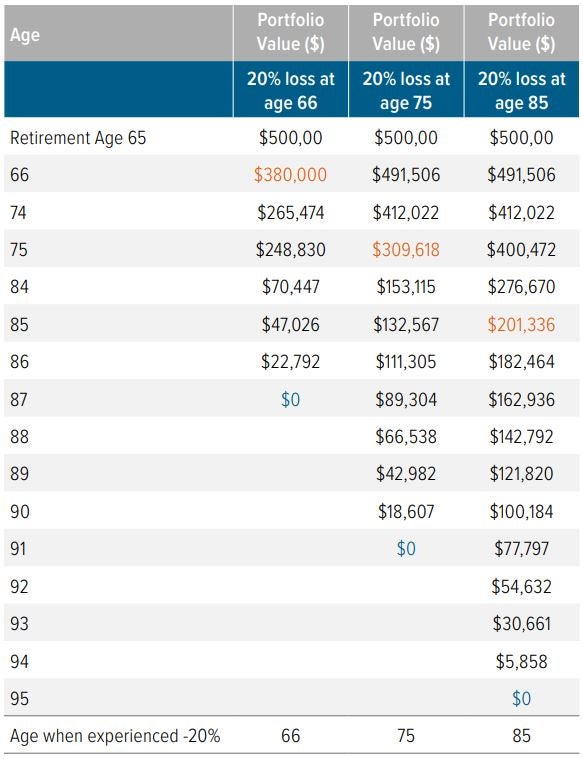
Plan sponsors often find the target date fund (TDF) selection process understandably daunting. Evaluating TDFs is a multi-faceted process that requires a deep dive into the four components of TDF design — glide path design, asset allocation, selecting underlying managers, and portfolio construction.
1. Glide Path Design
The most important factor in the lifecycle of TDFs is the design of its glide path. Each target date manager uses their own unique approach to glide path design, which results in a wide variety of equity allocations across the industry.
Glide path design should seek to avoid “sequence of return” risk (the risk of selling during or immediately following periods of poor performance) as participants enter retirement. Retirees are particularly vulnerable to this risk, due to lack of employment income, the need to make withdrawals, and the length of time that their retirement savings must support them. If the markets suffer a major downturn in the early years of a participant’s retirement, it will have a much more drastic effect on their savings than at any other time.
To illustrate this risk, Exhibit 1 shows a hypothetical scenario of three investors who have the same average rate of return throughout retirement but experience a 20% loss at different ages (age 66, 75, and 85). As the exhibit shows, a retiree who experiences a 20% loss at age 66 depletes their assets almost eight years earlier than a retiree who experiences a 20% loss at age 85.

This is a hypothetical example. Assumptions used in this analysis include: account balance at retirement of $500,000, annual return of 3.5% based on an equity/bond mix of 35%/65%, annual withdrawal rate of $25,000 (5% of the initial account balance) and a shock amount of -20%.
Source: Voya Investment Management
2. Asset Allocation
Portfolio management of TDFs requires more than just finding the ideal balance of stocks and bonds for a participant’s lifecycle. It’s also important to decide which sub-asset categories to add to the mix, and to understand how to adjust those sub-assets to manage the risks participants face. As with glide path design, target date managers diverge significantly when it comes to asset allocation. The number of asset classes that TDFs invest in can range from as few as five to up to fifteen or more.
Asset class correlations also matter. Combining asset classes that have low correlation to each other can minimize the highs and lows of a portfolio’s returns, compared with the return of each asset class on its own.
TDFs span a participant’s entire life cycle and must adjust to the changing risks participants face as they work, save, and retire. We believe TDFs should feature an active approach to asset allocation in managing sub-asset class exposures to reduce these different risks as they rise and fall over time.
3. Selecting Underlying Investment Managers
When evaluating a TDF’s underlying investment managers, plan sponsors may want to consider these three points:
- To what extent are the underlying managers diversified across investment philosophies and firms?
- What is the due diligence process for selecting and monitoring managers?
- Is there a dedicated team responsible for underlying manager research?
Few plan sponsors would ever consider constructing their core investment menu using just one investment manager. Most sponsors recognize that an investment menu offering a diversified roster of managers, including both active and passive styles, can help them better serve their participants and meet their fiduciary responsibility. This line of thinking is equally applicable when considering TDFs. We believe this approach offers the following advantages:
- Access to top managers
- Reduction of single-manager risk
- No capacity constraints
- Easy addition of new asset classes
4. Portfolio Construction: Putting It All Together
Building an effective portfolio involves more than just including top-performing strategies. To get the ideal balance of portfolio managers for each asset class — and for the portfolio as a whole — the TDF manager should consider all aspects of design that we’ve discussed here. They should also weigh the overall risk relative to the portfolio’s goals and restrictions.
According to our research, some equity and alternative asset classes have more potential to exceed their respective benchmarks (or alpha potential) than others. That’s why some TDFs allocate more to passive strategies in asset classes like U.S. large- and mid-cap equities that historically have had low alpha potential. Conversely, these same TDFs tend to favor active managers in small cap equities, international developed equities, emerging markets, real estate, and commodities — asset classes that historically have provided more alpha potential for active managers, even when accounting for higher fees.
Conclusion
In our view, a disciplined approach to each of the below four components should help participants prepare for a successful retirement:
- Glide path design that seeks to maximize risk-adjusted returns during the accumulation phase and to protect assets in the preservation and withdrawal phases of participants’ lifecycle
- Asset allocation across a variety of asset classes to maximize returns and minimize risk over the long term, while considering participant retirement age and other factors
- A range of underlying portfolio managers to provide an additional layer of diversification that may benefit participants
- Thoughtful portfolio construction that balances all aspects of target date design with the changing risks that participants face through an entire lifecycle
Click here to read our full commentary on holistic TDF design
